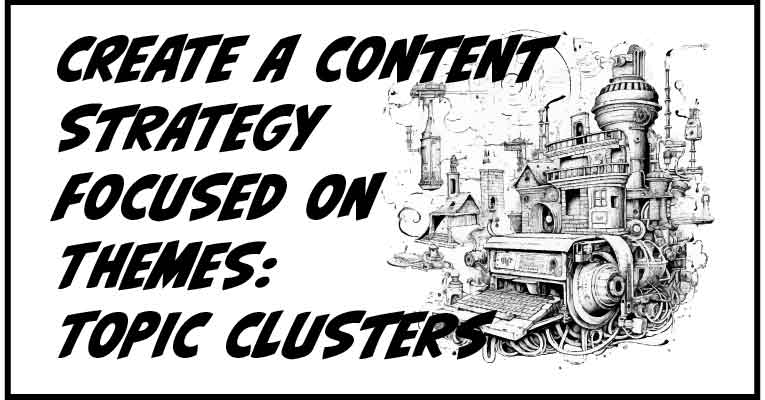At our most recent BestLyfe Group Mastermind Summit, we covered the dire need to have a content strategy.
Creating content willy-nilly isn’t a strategy, nor is it the best way to build momentum from the interest your content captures online. We know that inspiration can spark at any time, and that spark can turn into a wildfire of ideas, opportunities, and more.
But like a wildfire, unplanned content hits a bit of everything and yields unplanned results, for better or for worse.
Laser-focused content, on the other hand, takes that same spark of inspiration and channels the heat it creates down a specific channel. Planned content strategy yields results that are predictable, measurable, and, most importantly, reproducible.

The most efficient approach to developing an SEO content strategy is to plan your content around a central theme, what we call a topic cluster. When your content is structured in this way, the search engine algorithm recognizes that structure as the signature framework of an authority site.
THE ANATOMY OF A TOPIC CLUSTER
A topic cluster is SEO fancy-speak for themed content strategy.
That is interlinked.
Topic clusters have a pillar page, subtopic pages, and hyperlinks connecting these pages to one another. See the graph below.

About the Pilar Page
The pillar page covers your theme as a whole. It gives a comprehensive overview of a specific subject. For instance, if we use a marketing agency as an example, they would want to create a pillar page about Digital Marketing.
Digital Marketing is a topic that encompasses so many things it would be impossible to cover it all in one go. The agency would need to cover various aspects of digital marketing like, pay-per-click ads, email marketing, social media marketing, even content marketing, etc. It would be best to dedicate a page to each of these subtopics.
About the Subtopic Pages
Besides the obvious purpose of covering the topics that splinter off from the main subject matter, these pages are the building blocks of your cluster.
Each of these pages needs to link back to your pillar page, and (when it seems natural) link to other related subtopic pages as well.
For instance, a page about social media marketing could mention how social media posts are a great way to promote mailing list sign-ups then link to a related page in the cluster that covers email marketing.
About Your Interlinking Structure
The linking structure between your topic and subtopics is what binds your content together and sets it apart from a haphazard creation process that yields content.
Why Do Topic Clusters Matter For SEO?
Imagine walking into a room where a content writer sits at a desk with a typewriter, feverishly typing page after page of content.
When a page is done, the content writer yanks it out of the typewriter and tosses it into the air, then puts a new page into the typewriter and continues to create more content.
Eventually, the room is filled with pages of valuable content scattered all over the room. You’d be lucky if you could find a place to step.

When a search engine spider shows up in the room, it sees a bunch of scattered pages and thinks, “What the hell?”
It can’t really tell if the pages are related to one another, or if they cover a central theme, nothing. The spider leaves the room scratching its head, wondering, “What did I just see? Lord Google is not going to like this!”
This is what happens when businesses pump out content without a strategy and without structure. It’s difficult to build up SEO clout this way.
Now, imagine walking into a room where a content writer sits at a desk, feverishly typing pages of content but placing each completed page in a neat stack.
When the last page is written, the writer gets up and begins to interlink those pages, essentially binding them into a virtual book, and sets that book on a shelf in the room.

In both scenarios, the content is present in the same room, however, this time, when the search engine spider shows up, it looks around and immediately sees all the information neatly bound together. It thinks, “Oh! Wow, looks like they wrote a book on the subject.”
The spider whips out a clipboard to give your site a bump in credibility, authority, and SERP rankings. It leaves the room thinking, “I’ll have to tell Lord Google I’ve discovered another expert.”
SIDE NOTE: Stay on top of the subjects you cover in your clusters, update them with the most current information available, or create additional subtopic pages to address ongoing changes in the niche. This preserves your status as an authority site and, by extension, keeps your content high in the SERPs.
WRITE QUALITY CONTENT
We know writing quality content is easier said than done, so let’s lean into this topic and make the task much easier by focusing on what is most important for an SEO content strategy.
We’ll start by addressing the elephant in the room.
WHAT IS QUALITY CONTENT?
In a nutshell, it’s content worth reading. Yes, we know… That’s super vague and super subjective, so let’s get a little more objective on what that looks like.
Based on analytics and a vast body of online metrics, it turns out that content worth reading:
- Responds to the intent motivating a user query
- Solves a problem
- Adds value to the reader by contributing to some aspect of their survival and well-being
- Is empathetic
- Has purpose
- Has strong headlines
- Is easy to navigate
Of course, there are other factors, but if you’re looking for what has the greatest ability to keep your website visitors engaged and willing to take action, this list hits the factors that have the greatest impact. Make sure your content ticks each of these boxes.
To circle back to the list, specifically the third item on that list, when we speak of content that contributes to some aspect of the user’s survival and well-being, Google refers to these posts as Your Money or Your Life (YMYL). Any piece of content that contributes to the user’s “future happiness, health, financial stability, or safety.”
For instance, a roofing company could put out posts detailing the safety issues that arise when neglecting to take care of a roof, or the general dos and don’ts of filing insurance claims to cover roofing repair.
A baker who specializes in sugar-free treats can put out a series of posts that highlight the health benefits of their treats, like how they’re diabetic-friendly, and back those posts with another series of posts teaching web visitors about the best low-glycemic treats no one knows about.
It goes without saying that any entrepreneur working out of the legal, financial, medical, or health and fitness sectors can generate their fair share of YMYL content.
Another ranking factor Lord Google looks for in content is whether it “demonstrates aspects of Experience, Expertise, Authoritativeness, and Trustworthiness” (EEAT). If you “EEAT” well at Lord Google’s table, you will be anointed with great favor in the search results pages.
If you stick to a content cluster strategy for publishing your online content, write credible and engaging information, and look for an angle that incorporates YMYL, you’ll find yourself in the good graces of Lord Google over and over again.





